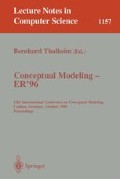Abstract
In the literature there are several proposals to map entity-relationship schemas onto object-oriented schemas, but they only treat relationship sets naÏvely or restrict them to binary relationship sets. We follow a different approach in the treatment of relationship sets. Our goal is to let the designer specify relationships of any arity and then to employ semantic constraints to decompose relationships into smaller fragments. The semantic constraints in use are functional constraints, which are defined in the object-oriented framework. The decomposition process guided by functional constraints is similar to the decomposition process in the relational approach with functional dependencies, but it takes advantage of the features provided by the object-oriented data model. In object-oriented schemas it is possible to enforce a certain kind of functional constraints automatically, namely unary functional constraints.
Preview
Unable to display preview. Download preview PDF.
References
S. Abiteboul and P. C. Kanellakis. Object identity as a query language primitive. In Proceedings of the 1989 ACM SIGMOD International Conference on Management of Data, pages 159–173, 1989.
P. Atzeni, G. Ausiello, C. Batini, and M. Moscarini. Inclusion and equivalence between relational database schemata. Theoretical Comput. Sci., 19:267–285, 1982.
C. Beeri. Formal models for object-oriented databases. In W. Kim, J.-M. Nicolas, and S. Nishio, editors, Proceedings of the 1st Deductive and Object-Oriented Databases (DOOD '89), pages 405–430, Kyoto, Japan, 1989. North-Holland.
J. Biskup, R. Menzel, and T. Polle. Transforming an entity-relationship schema into object-oriented database schemas. In J. Eder and L. A. Kalinichenko, editors, Advances in Databases and Information Systems, Moscow 95, Workshops in Computing. Springer-Verlag, 1996.
J. Biskup and U. RÄsch. The equivalence problem for relational database schemes. In Proceedings of the 1st Symposium on Mathematical Fundamentals of Database Systems, number 305 in Lecture Notes in Computer Science, pages 42–70. Springer-Verlag, 1988.
R. G. G. Cattell and T. Atwood, editors. The object database standard: ODMG-93; release 1.1. Morgan Kaufmann, 1994.
P. P.-S. Chen. The entity-relationship-model — towards a unified view of data. ACM Trans. Database Syst., 1(1):9–36, Mar. 1976.
C. Delobel and R. G. Casey. Decomposition of a data base and the theory of boolean switching functions. IBM J. Res. Dev., 17(5):374–386, 1973.
J. Demetrovics, L. O. Libkin, and I. B. Muchnik. Functional dependencies in relational databases: a lattice point of view. Discrete Applied Mathematics, 40:155–185, 1992.
R. A. Elmasri, V. Kouramajian, and B. Thalheim, editors. Proceedings of the 12th International Conference on Entity-Relationship Approach, Arlington, Texas, USA, 1993.
M. Gogolla, R. Herzig, S. Conrad, G. Denker, and N. Vlachantonis. Integrating the ER approach in an OO environment. In Elmasri et al. [10], pages 376–389.
R. Herzig and M. Gogolla. Transforming conceptual data models into an object model. In G. Pernul and A. M. Tjoa, editors, Proceedings of the 11th International Conference on Entity-Relationship Approach, number 645 in Lecture Notes in Computer Science, pages 280–298, Karlsruhe, Germany, 1992. Springer-Verlag.
R. Hull. Relative information capacity of simple relational database schemata. SIAM J. Comput., 15(3):856–886, 1986.
M. Kifer, G. Lausen, and J. Wu. Logical foundations of object-oriented and frame-based languages. J. ACM, 42(4):741–843, 1995.
Y. Kornatzky and P. Shoval. Conceptual design of object-oriented schemes using the binary-relationship model. Data & Knowledge Engineering, 14(3):265–288, 1995.
H. Mannila and K.-J. RÄihÄ. Practical algorithms for finding prime attributes and testing normal forms. In Proceedings of the Eighth ACM SIGACT-SIGMOD-SIGART Symposium on Principles of Database Systems, pages 128–133, 1989.
H. Mannila and K.-J. RÄihÄ. The Design of Relational Databases. Addison-Wesley, Wokingham, England, 1992.
R. Missaoui, J.-M. Gagnon, and R. Godin. Mapping an extended entity-relationship schema into a schema of complex objects. In M. P. Papazoglou, editor, Proceedings of the 14th International Conference an Object-Oriented and Entity Relationship Modelling, pages 205–215, Brisbane, Australia, 1995.
B. Narasimhan, S. B. Navathe, and S. Jayaraman. On mapping ER and relational models into OO schemas. In Elmasri et al. [10], pages 403–413.
P. Poncelet, M. Teisseire, R. Cicchetti, and L. Lakhal. Towards a formal approach for object database design. In R. Agrawal, editor, Proceedings of the 19th International Conference on Very Large Data Bases, pages 278–289, Dublin, Irland, 1993.
J. Rumbaugh. Relations as semantic constructs in an object-oriented language. In N. Meyrowitz, editor, Object-Oriented Programming Systems, Languages and Applications OOPSLA'87, pages 462–481, Orlando, Florida, 1987. acm Press.
B. Thalheim. Fundamentals of Entity-Relationship Modeling. Springer-Verlag, 1996.
G. E. Weddell. Reasoning about functional dependencies generalized for semantic data models. ACM Trans. Database Syst., 17(1):32–64, Mar. 1992.
Author information
Authors and Affiliations
Editor information
Rights and permissions
Copyright information
© 1996 Springer-Verlag Berlin Heidelberg
About this paper
Cite this paper
Biskup, J., Menzel, R., Polle, T., Sagiv, Y. (1996). Decomposition of relationships through pivoting. In: Thalheim, B. (eds) Conceptual Modeling — ER '96. ER 1996. Lecture Notes in Computer Science, vol 1157. Springer, Berlin, Heidelberg. https://doi.org/10.1007/BFb0019913
Download citation
DOI: https://doi.org/10.1007/BFb0019913
Published:
Publisher Name: Springer, Berlin, Heidelberg
Print ISBN: 978-3-540-61784-6
Online ISBN: 978-3-540-70685-4
eBook Packages: Springer Book Archive

